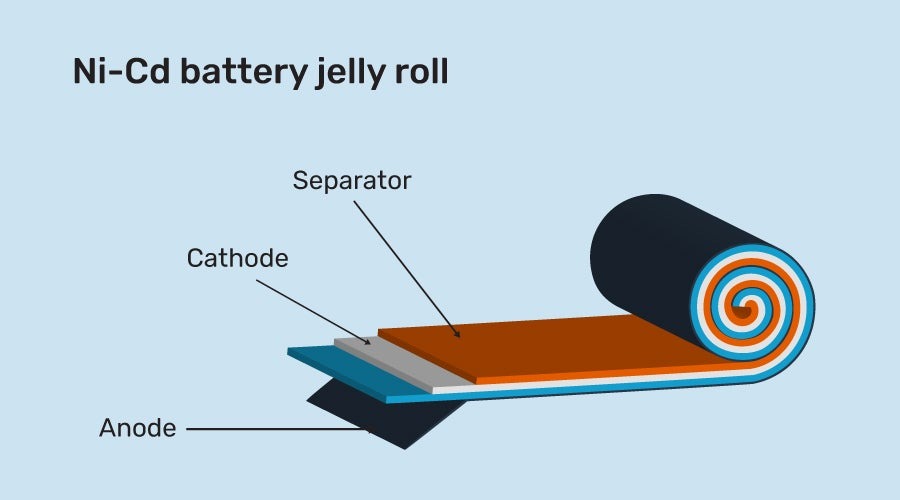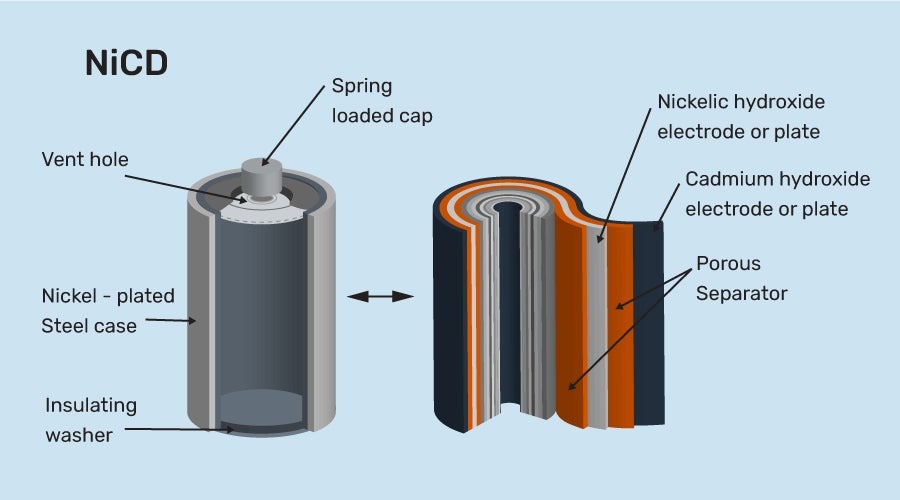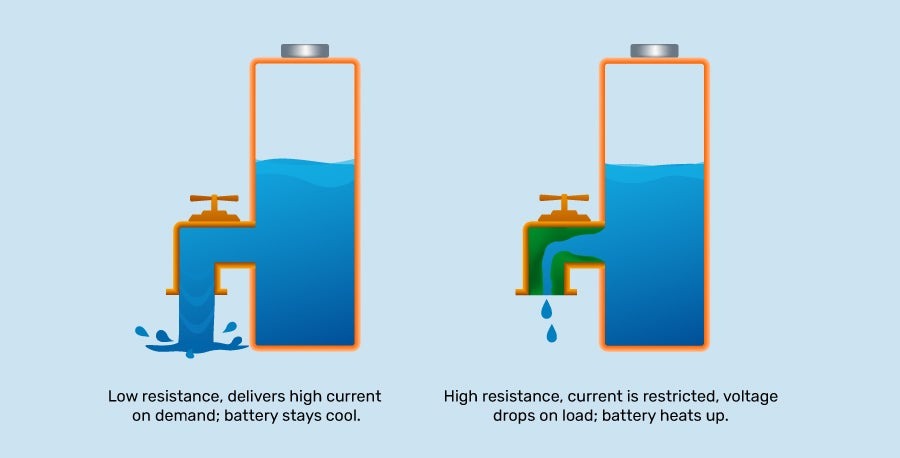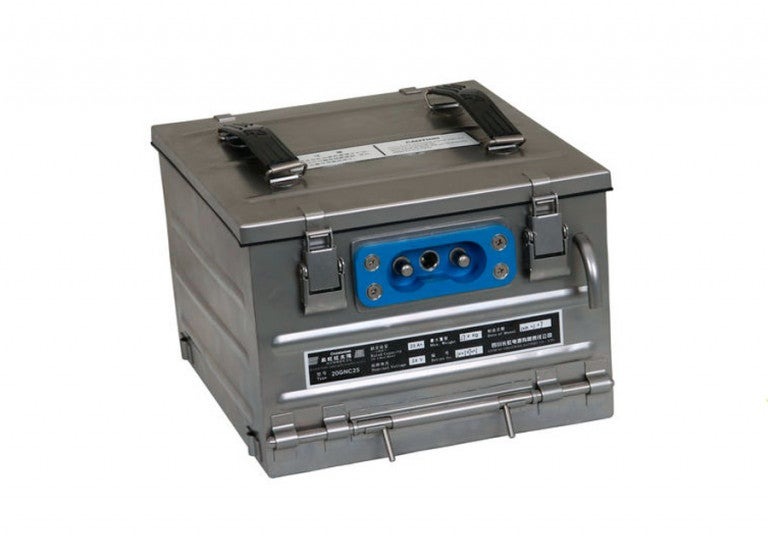Updated 3 months ago
The best uses for nickel cadmium (Ni-Cd) batteries
Written by Dan Hahn Dan HahnDan is a solar journalist and content advisor with SolarReviews. He also works with solar installers and solar nonprofits to develop and execute strat...Learn more

Why you can trust SolarReviews
SolarReviews is the leading American website for solar panel reviews and solar panel installation companies. Our industry experts have a combined three decades of solar experience and maintain editorial independence for their reviews. No company can pay to alter the reviews or review scores shown on our site. Learn more about SolarReviews and how we make money.
Commercial nickel cadmium (Ni-Cd) batteries weren’t popularized until the 1960s by Sanyo in Japan and the United States. Since then, Ni-Cd batteries became very popular for rechargeable home electronics, toys, and power tools.
More recently, Nickel Metal Hydride (NiMH) batteries have largely eaten away at their market share.
In this article, we’ll cover the unique features of Ni-Cd batteries, discuss their best applications, compare them to vastly more popular NiMH batteries, and discuss why there are better choices than Ni-Cd batteries for home solar energy storage.
Key takeaways
Ni-Cd batteries were very popular for power tools, toys, flashlights, and cameras until NiMH batteries were developed.
Ni-Cd batteries are still ideal for low-drain applications, like solar path lighting and solar Christmas lights.
Because Ni-Cd batteries last a long time and put out consistent power over the life of the charge, they are still used for industrial critical backup applications.
NiMH batteries have triple the capacity of Ni-Cd batteries and are more environmentally friendly.
Lithium-ion batteries are much more suited to home energy storage applications than Ni-Cd or NiMH batteries.
Features of Ni-Cd batteries
Nickel cadmium (Ni-Cd or “nicad”) batteries were invented way back in 1899 by a Swede named Waldemar Jungner. At that time, porous electrodes housed nickel, which was crafted into pockets for a nickel cadmium mixture to sit in and conduct electricity through.
After decades of research and experimentation, smart people found out that the more surface area inside a battery, the better for stronger electric currents.
Therefore, Ni-Cd batteries now resemble a “jelly-roll” inside, with porous anode and cathode plates sandwiching a separator and rolled up into a tasty charge with maximum power output.

At either end of an Ni-Cd battery is an electrode, the point at which electricity goes in and leaves. Ni-Cd batteries use an active material called nickel hydroxide at the positive terminal and metallic cadmium at the negative terminal. Inside is a liquid alkaline electrolyte solution, usually potassium hydroxide.

Cadmium is a highly toxic element, which has to be properly disposed of. In the United States, you can take them to a dedicated battery recycling center. While modern Ni-Cd batteries contain the cadmium quite well in the battery itself without leaking, the European Union banned portable Ni-Cd battery models in 2008.
How Ni-Cd rechargeable batteries are different from conventional alkaline batteries
Ni-Cd cells are available in the same sizes as alkaline types AAA through sub C and D, as well as in multi-cell combo packs which include the equivalent of a 9-volt battery.
They can pump out similar amps and have comparable milliamp-hours (mah) of capacity to other alkaline batteries. Through the years, they have been used quite a bit in home portable phones, vehicular toys, flashlights, power tools, and photo gear.
Ni-Cd batteries have several important differences from typical alkaline battery types, including:
They are rechargeable
Constant current
Fast charging and discharging
Can perform well in extreme temperatures
Longevity
They are rechargeable
Perhaps most obviously, Ni-Cd batteries can be recharged, while most other alkaline batteries will need to be thrown away after they’re used up.
For recharging, simply plop them in a battery charger for a charge cycle and they’re ready to go. However, they can be damaged if you overcharge them, so it’s recommended that they be removed from the battery charger after they reach 100%.
Constant current
Most alkaline batteries have cell voltages of about 2V, whereas Ni-Cd battery cells output 1.2V.
While that may sound like a bad thing, Ni-Cd batteries are able to crank out those 1.2 volts from each battery cell at full power until the battery is completely exhausted. While other batteries will slowly perform with less and less output over the course of a charge, Ni-Cd batteries can deliver constant voltage through each cycle life.
You may have had the experience of using a power tool like a drill which really screws the daylights out of any object it gets the opportunity to interact with after a fresh charge. Then a power difference becomes noticeable after 10 to 12 applications, after which that drill makes a depressing slow whirr and grinds to a halt.
Ni-Cds allow power tools to crank just as hard with screw number 4 as screw 60, right up until the very end of its charge.

Ni-Cd batteries can deliver such high power output because they have very low internal resistance. Similar to slime building up in your pipes that restricts the amount of water that can get out of your faucet, Ni-Cd batteries are built with less material which can obstruct the flow of electricity coming from the tank than other battery types.
Battery makers account for the 1.2 to 2 voltage difference by adding extra single cells to the Ni-Cd battery pack. That can make the voltage the same as a traditional battery, but allow the battery to still output constant high electricity throughout its charge.
Fast charging and discharging
Low internal resistance design also allows Ni-Cd batteries to discharge a lot of power quickly, as well as charge very quickly.
Can perform well in temperature extremes
Because resistance is low, Ni-Cd batteries also don’t easily overheat. That allows for their reliable usage in many rugged environments with wide temperature ranges.
Longevity
Ni-Cd batteries can last decades. As long as they don’t get destroyed from over-charging, you can expect them to keep working for years on end. Too much charge can cripple the vent in the battery, causing cells to dry out.
Maximizing your charge by avoiding the “memory effect” in a Ni-Cd battery
To keep your Ni-Cd batteries in good condition, it’s recommended to store them in a discharged state in a cool, dry place. After a year or two, it’s a good idea to run them through several charge and discharge cycles to recondition them. The reason why it’s useful to discharge them fully before charging is to counteract a mysterious phenomenon, called the “memory effect”. The memory effect is unique to Ni-Cd batteries.
When you regularly recharge a Ni-Cd battery after using it just a little bit, the battery seems to “remember” that it gets fed with more electricity after that specific amount of charge is depleted. What winds up happening is it gets lazy and stops working when you try to use more of its capacity beyond this typical charge level. It’s almost like having a headstrong child demanding more candy before finishing their homework.
So, to counteract this annoying battery psychology, it’s recommended to regularly drain your Ni-Cd battery before storage and recharge it fully before use.
Bringing dead Ni-Cd batteries back to life
If the memory effect wasn’t enough to spook you a little bit, how do you feel about the undead taking up residence in your Ni-Cd battery?
Even though Ni-Cd batteries may appear to be out of commission and not put out a charge after sitting around in your basement for years, they can be brought back to life by doing some “deep cycling”.
They’ll first come back as zombies with reduced capacity, but the more full charges and discharges you complete, they’ll start working like new again. The deep cycling process entails providing a jolt from a larger battery through some wires.
Check out the video below in which a crafty person rekindles a decades-old cordless drill Ni-Cd battery pack with just a spark and battery cycling.
Best applications for Ni-Cd batteries
Typically, Ni-Cd batteries are used when large capacities and high discharge rates are required, making them well-suited for use in RC cars, photography equipment, and home power tools which need a lot of power quickly.
These days, similar charge speed and higher battery capacity in the same size is offered by Nickel Metal Hydride (NiMH) batteries. That’s why you now see more of them in power tool batteries and even remote controls. We’ll cover them in more detail in the next section.
Best small-scale uses for Ni-Cd batteries

Image source: Review Geek
Solar lights: If you have solar Christmas lights, or garden path lights, Ni-Cd batteries are an excellent use case. That’s because they hold their charge significantly longer than NiMH batteries after they get direct sunlight in the middle of the day and sit idle in the late afternoon. That feature is referred to by battery nerds as a low “self-discharge rate”.
Also, they won’t put out less voltage to your lights over the course of the evening - they’ll still emit the same amount of power until the sun comes up the next day. And since they last longer than other battery types, you can count on consistent performance over many years.
Solar lighting manufacturers insist on using Ni-Cd rechargeable batteries, because they are best for their products. In fact, the chargers usually embedded in each light will only charge Ni-Cd cells.
Industrial uses for Ni-Cd batteries

Image source: Aerocontact
Critical backup power: Because they can put out reliable 100% power in a variety of conditions and temperatures, last a long time, and can be rekindled through reconditioning, industrial Ni-Cd batteries are still widely used for emergency backup power for aircraft avionic systems, nuclear power plants, and mass transit equipment (lighting, HVAC, brakes, intercom, and signaling).
Ni-Cd batteries vs NiMH batteries
Ni-Cd batteries have a lot going for them. Compared to most other battery types, these batteries:
Last longer
Retain their total charge while sitting idle longer
Output full power over the life of the charge
Can withstand high temperature fluctuations
Pros | Cons |
|---|---|
Long lifespan | Lower capacity |
Can withstand temperature fluctuations | Memory effect |
Consistent voltage output | Environmentally unfriendly |
Fast charge and discharge |
|
However, a newer rechargeable battery type, Nickel Metal Hydride (NiMH), delivers slightly over 300% of the capacity of a Ni-Cd battery - in the same size. For that reason, NiMH batteries are now used much more frequently in high-drain battery output applications, like camera equipment, handheld tools, and toys.
NiMH batteries also don’t have the annoying “memory effect”, meaning they perform consistently over charging and discharging cycles, no matter what pattern of partial charges are typically used.
However, NiMH do break down faster over time than Ni-Cd batteries do, and they age faster if they are discharged. That’s why it’s recommended they be fully charged before storing them.
Pros | Cons |
|---|---|
Higher capacity | Shorter lifespan |
No memory effect | Output diminishes over the charge |
Why Ni-Cd batteries are not ideal for home energy storage
Because Ni-Cd batteries last a long time and can charge quickly, you may wonder if it would be feasible to pair a large Ni-Cd industrial battery with a home solar system. If it weren’t for the environmental cost of using cadmium and the overall cost of the battery, it might be a practical idea.
In reality, home solar battery manufacturers have invested heavily in lead acid batteries, and recently much more in lithium ion technology instead. Therefore, the costs of these home solar batteries have dropped significantly over the past decade. For example, a Tesla Powerwall costs about $9,200 before installation.
With that said, we urge you to consider using lithium-ion batteries for your home solar system instead. While they last a little less longer, they are way more affordable, environmentally friendlier, easier to maintain, and are more straightforward when coupling them with your home solar power system and smart chargers.
Dan is a solar journalist and content advisor with SolarReviews. He also works with solar installers and solar nonprofits to develop and execute strategic plans. Dan Hahn founded residential solar energy information and policy resource, Solar Power Rocks, in 2007. As the site's chief architect and senior editor, he developed a national framework for evaluating the impact of residential solar energy policy. Possessed with a mission to communicat...
Learn more about Dan Hahn